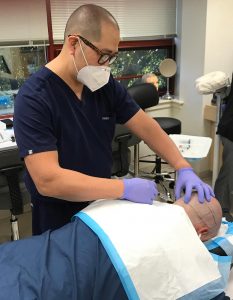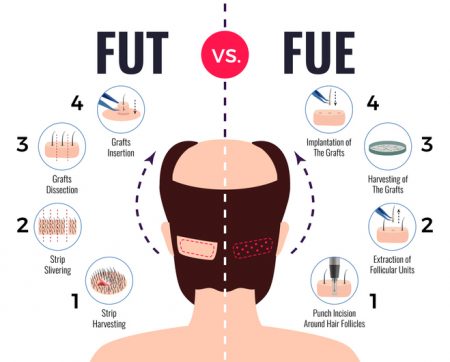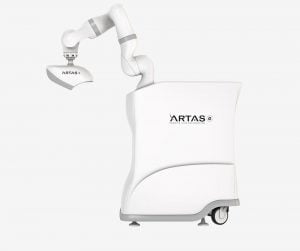
If you are experiencing hair loss, you’re likely weighing options for the best natural hair transplant method. The two main types of hair transplants are Follicular Unit Extraction (FUE) and Follicular Unit Transplantation (FUT). Both methods have their merits and points to consider. FUE is the more common hair transplant surgery method today. At The Lumen Center, we offer two breakthrough FUE hair transplant procedures that are considered game-changers in the hair restoration industry: the Robotic ARTAS iX® System and the NeoGraft® Automated FUE System.

Follicular Unit Extraction (FUE) is one of the latest advances in hair restoration. It is a method of surgically harvesting donor hair where it continues to thrive – typically on the back of the head or the sides. Then, it is transplanted to the area it is needed where the hair stops growing, or you are experiencing thinning hair. In male-pattern baldness, this is usually on the crown, top, or front of your head.
With the FUE method, individual follicular units are removed directly from the donor site on the scalp. An instrument is used to make a small, circular incision in the skin around the follicular unit or graft. A graft usually contains 1-4 hair follicles. Finally, tiny recipient sites are made in the balding or recipient areas of the scalp, and the transplanted hair is implanted.
One of the biggest benefits of an FUE Hair Transplant is no cutting or stitches, unlike a Follicular Unit Transplant (FUT), which leaves a linear scar. Other advantages of an FUE hair restoration surgery include:

FUE is a more modern and popular method of hair restoration. FUT, also known as strip surgery, differs from FUE in how the donor hair is removed. With FUT, a strip of tissue is removed from the donor area at the back of the head. This long incision creates a noticeable linear scar and requires staples or stitches to close the incision. This more invasive procedure is more painful and also has a longer recovery time than an FUE procedure. Aside from the extraction, implantation for the two procedures is much the same. Like the FUE procedure, the grafts using the FUT method are separated and then implanted into the recipient sites.
Most men with male pattern baldness and sufficient donor hair are good candidates for the follicular unit extraction procedure. Hair transplantation also may be an option for women with pattern baldness and thinning hair. However, women experience hair loss differently than men, with diffuse thinning throughout. We often pursue other hair restoration procedures as the first course of action. An FUE procedure is best if you:
 Both the ARTAS iX Robotic Hair Transplant System and Neograft Automated System are the most innovative devices in the industry to complete FUE. The ARTAS iX is also known as Robotic FUE and uses a physician-assisted robot to remove grafts from the donor area. The ARTAS is incredibly precise, efficient, and there is no chance of overharvesting donor hair. The NeoGraft uses an automated handpiece to gently extract hair follicles from a donor site and implant them where you need them. Both procedures produce exceptional, natural-looking results and all of the benefits of an FUE procedure. You and your hair transplant surgeon can discuss the best system to use for your hair transplant.
Both the ARTAS iX Robotic Hair Transplant System and Neograft Automated System are the most innovative devices in the industry to complete FUE. The ARTAS iX is also known as Robotic FUE and uses a physician-assisted robot to remove grafts from the donor area. The ARTAS is incredibly precise, efficient, and there is no chance of overharvesting donor hair. The NeoGraft uses an automated handpiece to gently extract hair follicles from a donor site and implant them where you need them. Both procedures produce exceptional, natural-looking results and all of the benefits of an FUE procedure. You and your hair transplant surgeon can discuss the best system to use for your hair transplant.
An FUE procedure requires skill, expertise, and high-tech tools to assist with excision. However, the total cost of the procedure will depend on several factors, including the number of grafts needed, the amount of density you want in balding or thinning areas, and the amount of donor hair available. Learn more about what to expect for the hair restoration surgery cost and the value a high-quality hair transplant surgeon can provide to your overall experience.
At The Lumen Center in Philadelphia, you won’t just get a great FUE hair transplant. You’ll also have a caring and compassionate team who is with you every step of the way on your hair restoration journey.
It starts with booking a complimentary consultation with Dr. Andrew Kwak, founder of Lumen and hair transplant surgeon. During your consultation, Dr. Kwak will perform your hair and scalp analysis, which includes determining how much donor hair you have available. He’ll also discuss the number of grafts needed, where to move the hair follicles, and will draw a proposed new hairline. He’ll review your options that both satisfy your concerns and achieve your hair growth goals.
Dr. Kwak will show you how he blends his artistry with the best technology in the hair transplant field. It’s the reason he has performed many hair transplant procedures with stellar, natural-looking results.

Sandra brings over 15 years of healthcare expertise to her role as a marketing writer, where she specializes in turning medical information into easy-to-understand content. Outside of work, she enjoys hiking with her family and reading.